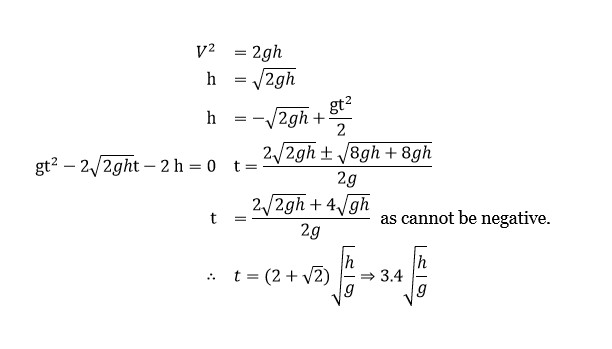Class 11th
Get insights from 8k questions on Class 11th, answered by students, alumni, and experts. You may also ask and answer any question you like about Class 11th
Follow Ask QuestionQuestions
Discussions
Active Users
Followers
New answer posted
2 months agoContributor-Level 9
f (f (x) = (a-f (x)/ (a+f (x) = x
Let f (x) = y. (a-y)/ (a+y) = x ⇒ a-y = ax + xy ⇒ a (1-x) = y (1+x) ⇒ y = a (1-x)/ (1+x)
⇒ f (x) = a (1-x)/ (1+x)
From the given options, we infer that comparing the derived f (x) leads to a=1.
⇒ a = 1
So f (x) = (1-x)/ (1+x)
f (-1/2) = (1 - (-1/2)/ (1 + (-1/2) = (3/2)/ (1/2) = 3
New answer posted
2 months agoContributor-Level 9
Equation of normal to the ellipse x²/a² + y²/b² = 1 at (x? , y? ) is a²x/x? - b²y/y? = a² - b².
At the point (ae, b²/a):
a²x/ (ae) - b²y/ (b²/a) = a² - b²
It passes through (0, -b).
a² (0)/ (ae) - b² (-b)/ (b²/a) = a² - b²
ab = a² - b²
Since b² = a² (1-e²), a²-b² = a²e².
ab = a²e²
a²b² = a? e?
a² (a² (1-e²) = a? e?
1 - e² = e?
e? + e² - 1 = 0
New answer posted
2 months agoContributor-Level 9
Let the first A.P. be a? , a? + d, a? + 2d.
a? = a? + 39d = -159
a? = a? + 99d = -399
Subtracting the equations, 60d = -240 ⇒ d = -4.
Substituting d back, a? + 39 (-4) = -159 ⇒ a? - 156 = -159 ⇒ a? = -3.
Now, for the second A.P. with first term b? and common difference D = d+2 = -2.
b? = a?
⇒ b? + 99D = a? + 69d
⇒ b? + 99 (-2) = -3 + 69 (-4)
⇒ b? - 198 = -3 - 276
⇒ b? = -279 + 198 = -81
New answer posted
2 months agoContributor-Level 10
F = (i + 2j + 3k)N
r = (4 - 1)i + (3 - 2)j + (-1 - 1)k)
τ = r x F
= (3i + j - 2k) x (i + 2j + 3k)
ijk
3 1 -2 ⇒ I (3 + 4) - j (11) + (6-1)k
1 3
7i - 11j + 5k
|τ| = √121 + 25 + 49
|τ| = √195 ; x = 195
New answer posted
2 months agoContributor-Level 10
B? = µ? I/ (2π (r)
|τ| = |I * l x F|
τ = 2aF
τ = 2 (a) (I) (2a) (µ? I/2πb)
τ = 2µ? I²a²/πb
B on the also equal to B? as
B = µ? I/ (2π√ (b² + a²/4) + µ? I/4
b >>> a
disp = ( kg/ms ²) (s) (m³/kg)
disp = (1) (16) (1/300) (1/1000)
disp in mm = 1000/ (300x100) = 0.03333
⇒ 3/100
New answer posted
2 months agoNew answer posted
2 months agoContributor-Level 10
dW? = Eqdx
∫ dU? = ∫ kQ/x² dxq
W? = kQq (-1/x)|? ^ (R+y)
W? = kQq (y)/ (R) (R + y)
W? + W? = 1/2 mv²
V² = 2/m (kQqy/ (R) (R+y) + mgy)
V² = 2y (kQq/ (m (R) (R+y) + g) ; k = 1/ (4πε? )
New answer posted
2 months agoContributor-Level 10
1/4 m (210)² = m (0.03) x (4.2) x 1000 x ΔT ; Q = mSΔt
ΔT = (210) (210)/ (4) (4.2) (0.03) (1000) = 87.5°C
New answer posted
2 months agoContributor-Level 10
f = V (n)/ (4 (1 - 17/100) (as closed from end)
f = (n - 2) (v)/ (4 (1 - 24.5/100)
nV (100)/4 (83) = (n - 2) (v) (100)/ (4) (75.5)
75.5n = 83 (n - 2)
75.5n = 83 (M - 2)
7.5n = 166
n = 22 (approx)
f = (330) (22) (100)/ (4 (83) = 2200 Hz
Taking an Exam? Selecting a College?
Get authentic answers from experts, students and alumni that you won't find anywhere else
Sign Up on ShikshaOn Shiksha, get access to
- 65k Colleges
- 1.2k Exams
- 679k Reviews
- 1800k Answers


